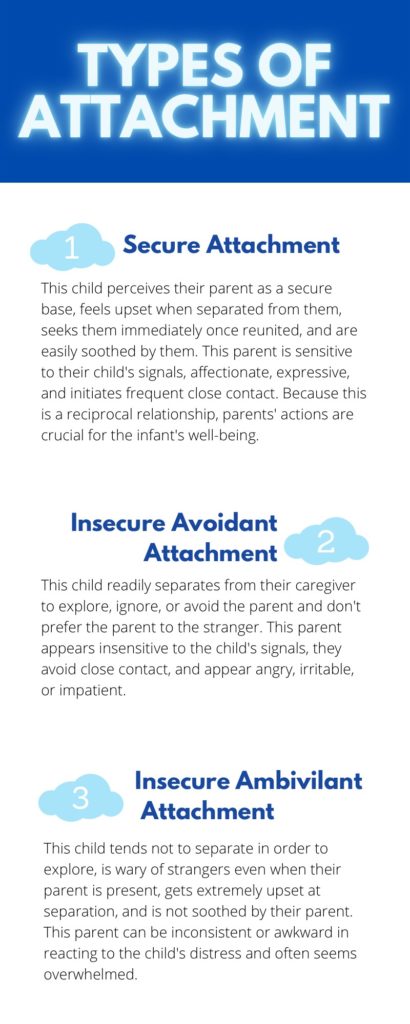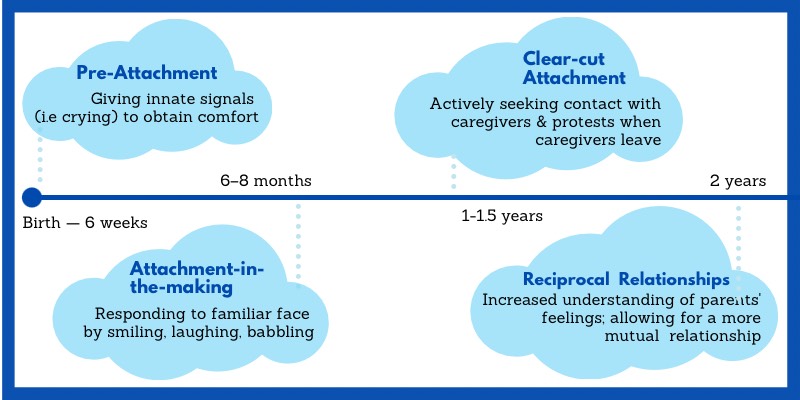Attachment theory is an important area of research that can help us understand relationships and bonds between people. All human relationships, especially during early childhood development, require a connection. But what is attachment, exactly? How does it form and what makes it healthy or unhealthy? And how does a healthy attachment help an infant learn?
In this article, we’ll review:
- The definition of attachment
- Attachment theory
- Stages of attachment during infancy
- The Strange Situation
- Types of attachment
- Learning through healthy attachment
- Learning through imitation and serve and return
- Infant education and resources
What Is Attachment?
Attachment is defined as an emotional bond with a particular individual transcending space and time. Infants who have a healthy attachment to their caregivers are more likely to thrive emotionally and socially than those who do not. There are several different types of attachment, but all involve a sense of trust and security. When the attachment is healthy, it can provide children with the foundation they need to develop into happy and well-adjusted adults.
Attachment Theory
Attachment theory is an area of focus within psychology that examines the importance of human relationships. According to attachment theory, when infants develop an attachment to a trusted caregiver, they form a “secure base” that allows them to explore the world. This security makes it possible for infants to feel safe enough to venture out and explore their surroundings.
Attachment theory is based on the work of psychoanalyst John Bowlby, who believed that mental health and behavioral issues could be attributed to early childhood experiences. His theory suggested that children are biologically predisposed to form attachments to caregivers to increase their chances of survival. According to Bowlby, there are four stages of attachment during infancy:
- Pre-attachment
Age: Birth to 6 weeks
Behavior: Innate signals (crying) to obtain comfort
- Attachment-in-the-making
Age: 6 weeks to 6–8 months
Behavior: Responds to familiar face by smiling, laughing, babbling
- Clear-cut attachment
Age: 6–8 months to 1 1⁄2 years
Behavior: Actively seeks contact with caregivers and protests when caregivers leave
- Reciprocal relationships
Age: 1 1⁄2 to 2 years and older
Behavior: Increased understanding of parents’ feelings, allowing for a more mutual relationship
The Strange Situation
Mary Ainsworth conducted a famous study in the 1970s known as the Strange Situation Experiment to measure attachment in infants. Researchers observed eight episodes, lasting approximately three minutes each, of when a mother, child and stranger are introduced, separated and reunited. This video demonstrates the results of the study, and through the observations, Ainsworth was able to identify different types of attachment.
Types of Attachment

Based on the observations of the Strange Situation, Ainsworth concluded that there are three major attachment styles: secure attachment, insecure/avoidant attachment, and insecure/ambivalent attachment.
- In a secure attachment, the child perceived their parent as a secure base, felt upset when separated, sought them when reunited, and was easily soothed by them. The parent seemed sensitive to the child’s signals, affectionate, expressive, and initiated frequent close contact. Because this is a reciprocal relationship, parents’ actions are crucial for the infant’s well-being.
- In an insecure/avoidant attachment, the child would readily separate from their caregiver to explore, ignore, or avoid the parent and did not prefer the parent to the stranger. The parent appeared insensitive to the child’s signals, avoided close contact, and portrayed anger, irritability, or impatience.
- In an insecure/ambivalent attachment, the child tended to not separate to explore, was wary of the stranger even when the parent was present, was extremely upset at separation, and not soothed by their parent. The parent presented as inconsistent or awkward in reacting to the child’s distress and often seemed overwhelmed.
A healthy, secure attachment is essential for a child’s development and learning. It sets the tone in infancy for how babies confidently learn and explore the world around them. When infants feel safe exploring, they can then begin learning.
So, how do infants learn? They learn through different types of experiences and interactions.
Learning Through Healthy Attachment
As soon as an infant is born, they begin to learn and understand the world from observation and experiences. Their brains form rapidly, creating new neural connections daily as they notice how their needs are being met. When an infant cries because they are hungry and their caregiver responds with nutrition, they begin to understand that they can get what they need through communication, however that may be expressed. Besides providing the infant with what they need, this sense of security also forms the first signs of a secure attachment.
Learning Through Imitation
Imitation is a crucial aspect of skill development because it allows us to learn new things quickly and efficiently by watching those around us. Imitation can begin even in the first four weeks as newborns have been observed to mimic facial expressions. At around eight months of age, children imitate simple actions and expressions of others during interactions. Most children learn everything from gross motor movements to speech and interactive play skills by watching parents, caregivers, siblings, and peers perform these behaviors.
Infants Learn and Develop Quickly
When a baby is born, they can recognize human faces quickly, and while their eyesight is limited at first, they prefer to look at familiar faces. In a study on newborns, infants were shown images of intact faces or scattered faces on paddles. The researchers would move the paddles along the newborn’s line of sight. The results showed that the newborns preferred the intact faces since they followed them for longer than the paddles with the scattered faces. This fascinating study shows how rapidly a newborn learns and develops.
What Is Serve and Return?
Serve and return strengthens the child’s brain and supports the development of communication and social skills. When infants are young, they are constantly learning, so when an adult responds appropriately to their cries, gestures, or babbles, neural connections are strengthened in the child’s brain. Not only does serve and return help in the child’s development, but it can also enhance the parent-child relationship. This reciprocal interaction conveys to the infant that they can communicate their needs and be heard and responded to by the caregiver.
Strengthening Serve and Return Interactions
Often, caregivers are serving their attention, time, and encouragement while the infant is serving through interactions and development.
Serve and return can be more impactful when caregivers provide their full attention. A simple way to do this is by putting your phone away and giving your undivided attention to your infant. While juggling many tasks is often our only option in today’s busy society, taking time to be in the moment with your child allows the serve and return to be much stronger.
Learn (even) More at Lemberg Cloud
By understanding the different ways infants learn, parents, caregivers, and educators can create an environment that supports optimal growth and development. If you’re looking for more opportunities to learn about infant development, please visit our page dedicated to Infant Education and Resources. There you will find a wealth of information, including infant education, play examples, brain development, whitepapers, and videos from some of the leading experts in the field.
Additionally, If you want to stay up-to-date on infant learning and development, please sign up for our newsletter. We send new articles every month that will help you understand how your child is learning and developing. You’ll also learn about the best ways to support your child’s growth and development. Don’t miss out – sign up today!

